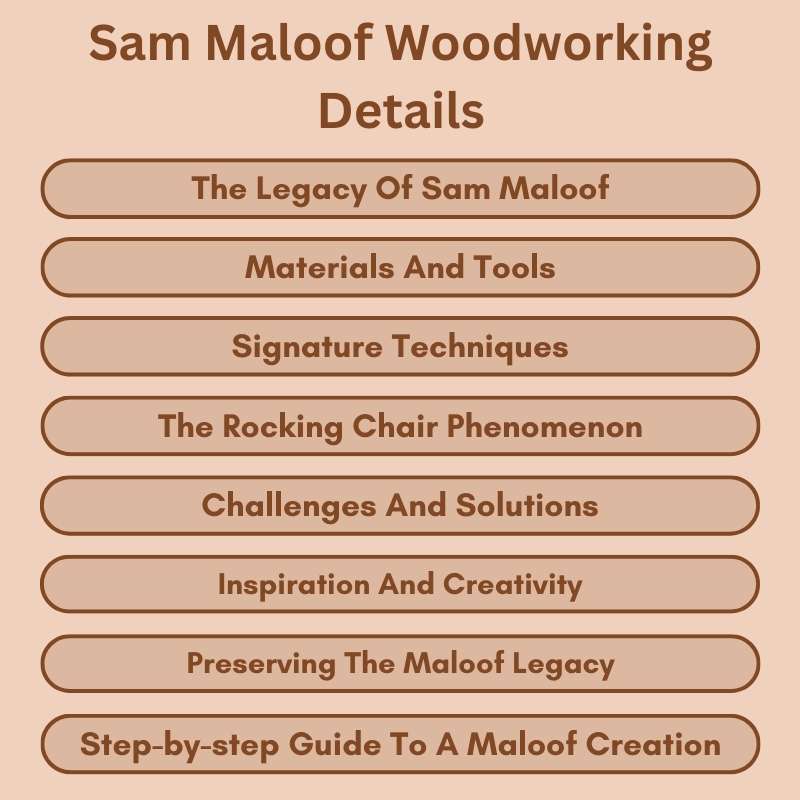Sam Maloof was a renowned American woodworker known for his innovative designs and craftsmanship. His work combines functionality with striking aesthetics, often featuring organic shapes and natural finishes.
Sam Maloof’s woodworking style revolutionized the furniture industry, blending artistry with everyday use. His pieces, often made from hardwoods like walnut and cherry, highlight the beauty of natural materials. Maloof’s signature rockers and tables showcase smooth lines and ergonomic designs, making them both comfortable and visually appealing.
He emphasized the importance of handcrafting, ensuring each piece was unique. Maloof’s influence extends beyond furniture; he inspired countless artisans with his dedication to quality and design. Exploring Maloof’s work offers insight into a legacy that continues to shape contemporary woodworking today.
The Legacy Of Sam Maloof
Sam Maloof was a famous woodworker. He started his journey in the 1920s. His early years shaped his style. Many artists and craftsmen influenced him. They inspired his unique vision.
Maloof’s furniture is known for its curved lines and organic shapes. Each piece tells a story. The use of natural materials adds warmth and beauty. His work often combines functionality with artistic flair.
Many collectors and museums admire his creations. His designs are a blend of tradition and innovation. Sam’s legacy continues to inspire new generations of woodworkers.

Materials And Tools
Choosing the right wood is essential for Sam Maloof-style furniture. Hardwoods like walnut, cherry, and maple work best. These woods are strong and beautiful. They also take stain and finish well.
Consider the grain patterns when selecting wood. Unique grains enhance the beauty of your furniture. Look for pieces with fewer knots and defects.
Essential tools for Maloof-style furniture include:
| Tool | Purpose |
|---|---|
| Table Saw | For accurate cuts and shaping wood. |
| Router | To create decorative edges and joints. |
| Chisels | For fine details and intricate designs. |
| Sandpaper | To smooth surfaces and prepare for finishing. |
Signature Techniques
Sam Maloof’s woodworking style includes unique techniques. His sculptural joinery stands out in every piece. This method creates strong and beautiful connections.
One key feature of Maloof’s work is seamless curves. These curves enhance the aesthetic appeal of his furniture. They create a sense of flow and movement. Each curve looks natural and elegant.
Using hand tools, he shapes wood to perfection. This craftsmanship requires skill and patience. Maloof’s techniques inspire many woodworkers today. His work remains a benchmark in the world of woodworking.
The Rocking Chair Phenomenon
The rocking chair phenomenon started with Sam Maloof’s unique designs. His chairs blend comfort and style. The design evolution emphasizes smooth lines and natural shapes. Each chair tells a story through its wood grain.
Crafting steps begin with selecting the right wood. Maloof preferred hardwoods like walnut and maple. He shaped each piece with care, ensuring a perfect fit. Sanding and finishing brought out the wood’s natural beauty.
Global recognition followed as collectors admired Maloof’s work. His rocking chairs became symbols of American craftsmanship. They are displayed in museums around the world. Fans cherish both their beauty and functionality.
Challenges And Solutions
Woodworking often presents challenges with material limitations. Sam Maloof faced this issue with his unique designs. He chose local woods that were available and sustainable.
By experimenting with different types of wood, he found new creative solutions. His work shows that limitations can inspire innovation.
Traditional methods played a key role in Maloof’s style. He used hand tools to shape and refine his pieces. This approach gave his furniture a distinctive touch.
Combining modern techniques with old methods allowed for greater flexibility. Maloof’s ability to adapt made his work timeless and well-respected.
Inspiration And Creativity
Nature serves as a powerful source of inspiration for Sam Maloof’s work. His designs often reflect the beauty of natural forms. Each piece captures the essence of wood, showcasing its unique grain and texture.
Maloof believed in the fusion of form and function. Furniture should be beautiful and practical. His chairs and tables offer both comfort and style. Every detail matters, from the curves to the finishes.
The harmony between aesthetics and usability makes his creations timeless. Sam Maloof’s woodworking continues to inspire many artists today. His legacy is one of creativity and respect for nature.
Preserving The Maloof Legacy
Sam Maloof’s work is famous for its beauty and craftsmanship. Preserving the Maloof legacy is important for future generations. Educational programs help people learn about Maloof’s techniques. These programs inspire young woodworkers to explore their creativity.
Many museums and exhibits showcase Maloof’s incredible pieces. Visitors can see his unique style up close. Exhibits often feature interactive displays. These allow guests to try woodworking techniques themselves. Education about woodworking plays a crucial role in keeping Maloof’s spirit alive.
| Program Type | Description |
|---|---|
| Workshops | Hands-on learning experiences for all ages. |
| Lectures | Expert talks on Maloof’s impact on woodworking. |
| Exhibitions | Showcasing Maloof’s work and techniques. |
Step-by-step Guide To A Maloof Creation
Start with clear preparation. Gather all necessary tools and materials. Sketch your design on paper. This helps visualize the final product.
Measure and cut the wood pieces accurately. Use a saw for precise cuts. Sand each piece to avoid splinters. Smooth edges create a better finish.
Next, plan the assembly. Use wood glue for strong bonds. Clamps help hold pieces together while drying. Ensure everything is aligned properly.
After assembly, apply your chosen finish. Stain or varnish enhances the wood’s beauty. Allow it to dry completely for best results. Enjoy your Maloof creation!

Frequently Asked Questions
What Is Sam Maloof Known For In Woodworking?
Sam Maloof is renowned for his unique, sculptural furniture designs. His work blends craftsmanship with artistry, creating pieces that are both functional and visually striking. Maloof’s signature style features smooth lines and organic shapes, often using native hardwoods. He is also celebrated for his innovative joinery techniques.
How Did Sam Maloof Influence Modern Woodworking?
Sam Maloof significantly influenced modern woodworking by emphasizing design and craftsmanship. His approach inspired many woodworkers to prioritize aesthetics alongside functionality. Maloof’s techniques and styles set new standards in the craft, encouraging a blend of art and furniture making. His legacy continues to inspire contemporary artisans.
What Materials Did Sam Maloof Typically Use?
Sam Maloof primarily used hardwoods, including walnut, cherry, and oak. He favored these materials for their durability and beauty. Maloof often showcased the natural grain and color of the wood in his designs. This choice of materials contributed to the timeless appeal of his furniture.
Where Can I See Sam Maloof’s Work Today?
You can see Sam Maloof’s work in various museums and galleries. Notable locations include the Smithsonian American Art Museum and the Los Angeles County Museum of Art. Many of his pieces are also showcased in private collections. Visiting these institutions offers a glimpse into his extraordinary craftsmanship.
Conclusion
Sam Maloof’s woodworking showcases exceptional craftsmanship and timeless design. His commitment to quality and attention to detail set a high standard in the industry. From furniture to sculptural pieces, Maloof’s work continues to inspire artisans and enthusiasts alike. Embracing his techniques can elevate any woodworking project to new heights.

